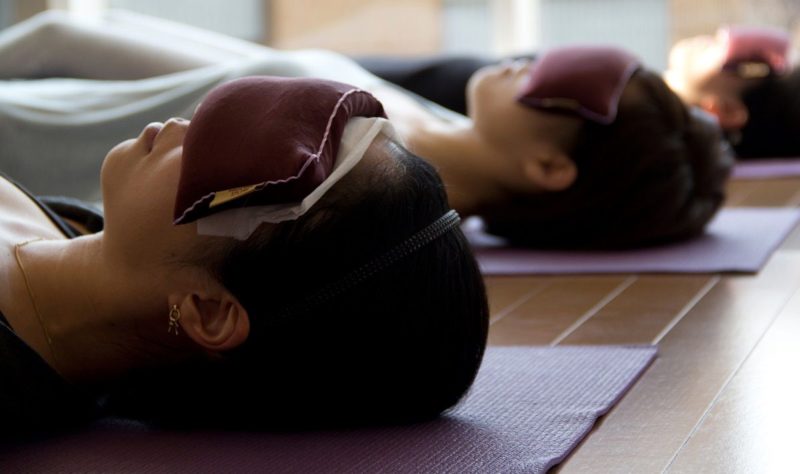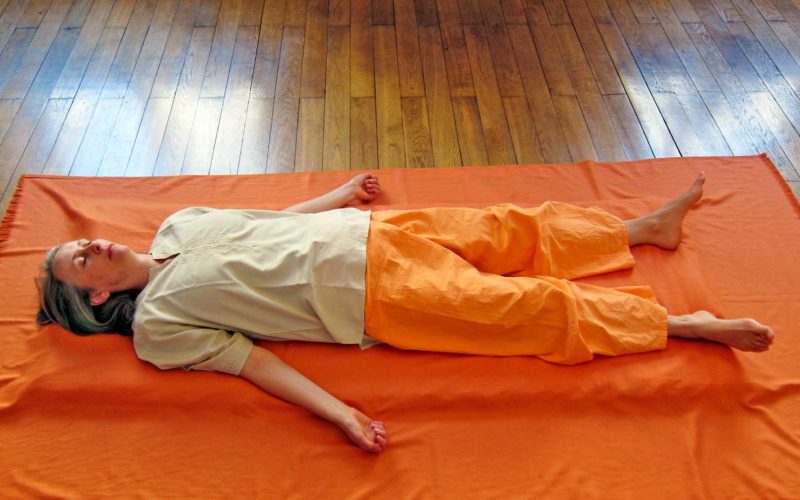A good healthy sleep is the key to the restoration of the body and nervous system. Yoga nidra, a special yogic practice, the effect of which is similar to a good sleep, will help strengthen its use for the body and normalize the psycho-emotional state of a person. Nidra yoga can be mastered independently, because it is based on meditation and the ability to cleanse the mind. In addition, the effectiveness of this practice has been scientifically proven, so there is no doubt in its effectiveness.
Material Content:
What is yoga nidra
The literal translation of the name of the practice is "yoga for sleep." It is for this purpose that it is used - as a substitute for sleep, when there is no time for a good rest, and as a way to improve the quality of sleep, but shorten its duration. The term was proposed by Swami Satyananda Saraswati, but he dedicated several books to this technique.
Yoga Nidra helps to know oneself by interacting with one’s own subconscious. In addition, it strengthens the nervous system, promotes relaxation and purification of consciousness, which is why it is widely used in modern psychology.
The aim of the practice is to achieve the borderline state between sleep and wakefulness, followed by interaction with the subconscious and the psyche by focusing on one point on the body. In general, mastering this practice on your own is relatively simple; the main thing is to take the matter seriously.
Description of the practice of yogic sleep
The purpose of the lesson is to achieve a state on the border between sleep and reality, when all feelings are dulled, but the person is aware of the surrounding reality. It is important not to confuse this state with a half-nap, which is quite simple to achieve.
To better understand when you need to work with your subconscious, you need to remember the moment before the beginning of deep sleep. Usually it lasts no more than a few minutes, or even limited to seconds. Yoga Nidra helps prolong this condition. In this phase, between sleep and reality, metabolic processes in the body slow down, which contributes to deep relaxation and good rest.
Interestingly, the hour of yogic sleep in effectiveness is equal to four hours of normal night rest.
In addition to rest and relaxation, yoga nidra allows you to work with the subconscious. During classes, a person sets the setting and sets new goals. In yogic practice, this is indicated by the term “sankalpa” - the mental “voicing” of intentions, desires and goals, which become a life attitude. Sankalpa gains enormous power during a yogic dream. If the desire is usually expressed and sent into space, then the nidra helps to convey the installation to the subconscious, programming a person to constantly strive to achieve the goal.
Practicing psychologists fell in love with this practice, as it allows them to bring out subconscious blocks, negative attitudes and hidden fears, in order to subsequently work them out and permanently close gestalt.
Benefit for health
Yoga nidra is a real anti-stress. Its action is primarily aimed at strengthening the nervous system and achieving deep relaxation, which helps to restore the entire body.
Useful effect on the psyche:
- elimination of the destructive effects of stress;
- anxiety reduction;
- getting rid of fears and insecurities;
- reduction of manifestations of depression.
In addition, the deep relaxation technique helps clear the mind and focus on really important things. As a result, the concentration of attention increases, memory and reaction speed improve, which will definitely have a positive effect on the working activity of a person.
Another positive feature of this practice is the disclosure of a person’s creative potential. Do not be surprised if, after practicing yoga, a desire suddenly appears to draw, write poetry or compose music.
A positive effect on the psyche and brain activity is due to an increase in the level of dopamine, which is produced during the borderline state between sleep and wakefulness.
This hormone belongs to the neurotransmitters of mood, and its lack provokes the development of depression, anxiety syndrome, apathy and asthenia. An increase in dopamine levels also has a positive effect on the rate of metabolic processes in the brain, which improves cognitive functions and improves mood. Therefore, it is safe to say that yoga nidra is the practice of smart and happy people.
Recent studies have shown that this trend in yoga can be effectively used as part of the rehabilitation of drug addicts. Self-study will help you quit smoking, stop drinking alcohol, or follow a diet for obese patients.
A person practicing yogic sleep eventually forgets about headaches, lack of sleep, and a feeling of frustration after waking up. Regular practice teaches you to quickly relax and recover faster even in a short time. As a result, the required duration of sleep is reduced by an average of 1-2 hours, and every morning brings the joy of a new day, rather than complaining about lack of sleep.
Base complex, equipment
Nidra technique includes two stages - preparation and work with the subconscious.
To help beginners presented a lot of audio recordings and videos that will help you tune in to work.
It is enough to include such a recording and follow the voice of the announcer. It is first necessary to lie on the rug in the so-called dead man's pose - Shavasana.Then you need to relax and follow the recommendations of the announcer, gradually relaxing each muscle, moving consciousness from the bottom up.
During relaxation, it is necessary to breathe calmly and deeply, the muscles of the face should be relaxed, the eyes closed. At some point, arbitrary tremors and contractions of the muscles of the extremities, a sensation of falling or seeing, can begin - this is absolutely normal and natural in moments of weakening control over the body.
The next stage is the transition to a special state between sleep and wakefulness. There is more intensive work ahead. To master the technique, you must follow the instructions.
- Feel the incredible heaviness of your own body. It becomes so heavy that the floor does not stand up and takes it into itself.
- Next, feel that the body is completely weightless, so it hovers above the floor.
- These ideas must be repeated several times, alternating heaviness with ease, and then consciously give yourself a setting or sankalpa.
- Desire must be mentally repeated three times.It is important that the sankalpa bears a positive meaning and is aimed at making a person’s life better.
- Slowly “walk” the consciousness through each muscle, gradually increasing the pace and bringing it to the point that in a split second the mind manages to embrace and feel the whole body.
- Make yourself feel different sensations - temperature difference (cold, heat), tickling, pain, soft stroking, etc.
- Repeat the installation three more times, at the same time “covering” your body from above, feeling how consciousness has left it and exists separately.
- Then you need to say the mantra "Ohm" and "return" to your body.
After, you can move your arms and legs, restoring sensations, and sit in a comfortable position. If you just need to relax and relieve stress, you can lower the sankalpa.
In fact, yoga nidra is a kind of meditation. It can be used as part of a lesson in any other area of yoga.
Beginners often lose control by allowing various thoughts. Many complain that they cannot imagine a feeling of cold or warmth, or even relax the whole body. It is important to be patient. If the first time you didn’t fully master the practice, you don’t have to give up, over time the skill will come by itself.
The similarities and differences of yoga nidra and hypnosis
The borderline state when doing yoga can flow into a hypnotic trance if a person loses control over his consciousness. To prevent this from happening, in all audio recordings leading a person as he plunges into a borderline state, the refrain “don't sleep” is constantly repeated. In addition, nidra is aimed at strengthening communication with the subconscious, and hypnosis, on the contrary, distracts consciousness and immerses in a trance in which a person completely loses control and becomes susceptible to the commands of the hypnotist.
Yoga nidra is more like a dream in which a person controls the visions and can wake up at any time.
Contraindications
This practice is safe and has no contraindications. However, with severe disturbances in cerebral circulation, unpleasant sensations may appear, including dizziness, tinnitus, and fainting. In this case, it is better to abandon further attempts to master this area of yoga. It is also not recommended to independently practice nidra for people with epilepsy and those who have recently suffered a brain stroke.
Yoga nidra is a great way to fully relax in 15 - 20 minutes during periods of intense stress, both physical and psycho-emotional. Everyone can master the practice, especially it is recommended for people suffering from insomnia and those for whom 8 - 9 hours of sleep is not enough to feel awake and full of strength.
















